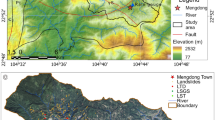Abstract
In this study, we combined a program to optimize forest road alignments with a method for prediction of surface erosion and related sediment delivered to streams. Combining the forest road design program with the high-resolution digital elevation model made it possible to estimate soil sediment based on a standard methodology, because a relatively accurate road prism could be generated. The combined program properly places and spaces drainage structures based on the Washington State Forest practice board manual. We applied the program to a part of Capitol State Forest in Washington State and optimized horizontal and vertical alignments while estimating movement of soil sediment from roads to streams. We discussed the effects of road surface materials, near-stream culvert distance to stream, and out-sloped forest road template on total road costs and soil sediment delivered to streams. Using lower quality rock surfacing reduced total costs, but the amount of soil sediment from lower quality rock surfacing was 1.5 times more than that on a higher quality rock traction surface. Therefore, lower quality rock surfacing should not be used near the stream. The placement of near-stream culverts 15 m upstream and out-sloped road template were examined using a traction surface on 15-m sections upstream and lower quality rock surfacing on other sections in order to reduce soil sediments to the stream and total costs. As a result, placing near-stream culverts 15 m upstream and using an out-sloped road template significantly reduced total road cost and soil sediment. Finally, we optimized horizontal and vertical alignments while limiting soil sediment to a specified maximum level. The model successfully optimized forest road alignments, which reduced total road cost as well as soil sediment.
Similar content being viewed by others
References
Anon. (1997) Standard methodology for conducting watershed analysis manual, ver 4.0. Washington State Department of Natural Resources, Olympia, Washington
Anon. (1999) Cost estimating guide for road construction region 6. USDA Forest Service, Portland, Oregon
Anon. (2001) Forest practice board manual. Washington State Department of Natural Resources Olympia, Washington
Aruga K, Sessions J, Akay AE, Chung W (2004) Optimizing horizontal and vertical alignments of forest roads using a high-resolution DEM. International Mountain Logging Conference, Vancouver, British Columbia
K Aruga J Sessions AE Akay (2005a) ArticleTitleHeuristic techniques applied to forest road profile J For Res 10 83–92
K Aruga J Sessions AE Akay (2005b) ArticleTitleApplication of an airborne laser scanner to forest road design with accurate earthwork volumes J For Res 10 113–123
Burroughs ER Jr, King JG (1989) Reduction of soil erosion on forest roads. General Technical Report INT-264. USDA Forest Service, Intermountain Research Station, Ogden, Utah
Cain C, Langdon JA (1982) A guide for determining minimum road width on curves for single-lane forest roads. Engineering Field Notes, Volume 14, USDA Forest Service
SM Easa (2003) ArticleTitleEstimating earthwork volumes of curved roadways: simulation model J Surv Eng ASCE 129 19–27 Occurrence Handle10.1061/(ASCE)0733-9453(2003)129:1(19)
F Glover (1989) ArticleTitleTabu search Part I. ORSA J Comput 1 190–206
Kramer BW (2001) Forest road contracting, construction, and maintenance for small forest woodland owners. Oregon State University, Forest Research Laboratory, Research Contribution 35
FL Mannering (1990) Principles of highway engineering and traffic analysis Wiley New York
R Mayer R Stark (1981) ArticleTitleEarthmoving logistics J Const Div 107 297–312
Megahan WF (1974) Erosion over time on severely disturbed granitic soils: a model. USDA Forest Service. Research Paper INT-156
K Oohashi (2001) Michi dukuri no subete National Forestry Extension Association Japan, Tokyo
S Reutebuch RJ McGaughey H-E Andersen W Carson (2003) ArticleTitleAccuracy of a high-resolution LiDAR-based terrain model under a conifer forest canopy Can J Rem Sens 29 1–9
Schiess P, Krogstad FTO (2003) LiDAR-based topographic maps improve agreement between office-designed and field-verified road locations. Proceedings of 23rd Council on Forest Engineering Conference, Bar Harbor, Maine
S Watanabe (1998) ArticleTitleBosai suigen kannyo romo no teisho Sanrin 1367 2–10
Author information
Authors and Affiliations
Corresponding author
About this article
Cite this article
Aruga, K., Sessions, J. & Miyata, E. Forest road design with soil sediment evaluation using a high-resolution DEM. J For Res 10, 471–479 (2005). https://doi.org/10.1007/s10310-005-0174-7
Received:
Accepted:
Issue Date:
DOI: https://doi.org/10.1007/s10310-005-0174-7




